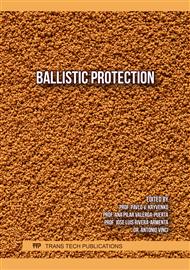[1]
W Zhou, P Ge, H Y Xin, X N Mao, Q Hong, Y L Qi, Penetration Damaging behavior of a sort of high strength titanium alloy target, Rare Metal Materials and Engineering [J], 2013, 42(4):781-784.
Google Scholar
[2]
K Sun, F C Wang, X W Cheng, P Miao, S Z Zhao, Fine structure of adiabatic shear band of TC6 alloy under different evolvement stages, Rare Metal Materials and Engineering [J], 2009, 38(2):233-236.
Google Scholar
[3]
Z S Zhu, Resent research and development of titanium alloys for aviation application in China Journal of aeronautical materials, 2014, 34(4): 44-50.
Google Scholar
[4]
Pitler R. and Hurlich A., Some Mechanical and Ballistic Properties of Titanium and Titanium Alloys, Report #401/17, Watertown Arsenal Laboratory, March (1950).
Google Scholar
[5]
Sliney J., Status and Potential of Titanium Armor, Proceedings of the Metallurgical Advisory Committee on Rolled Armor, AMRA MS 64-04, U.S. Army Materials Research Agency, January (1964).
Google Scholar
[6]
Metals Park, OH: ASM International, 1989 MIL-DTL-46077G, Armor Plate, Titanium Alloy, Weldable, 28 September (2007).
Google Scholar
[7]
R P Guo, BS Sun, BB Gao, Low cost manufacturing technology of titanium alloy used in ordnance equipment. Ordnance Material Science and Engineering. 2008, 31(5): 83-85.
Google Scholar
[8]
G Wa, CX Zhang, Process of the low-cost titanium alloy and its military application, Titanium industry progress, 2008, 25(3):6-10.
Google Scholar
[9]
J Zhai, W J Xin, A Z Guo, H Y Xin, Z L Liu, Protection properties and ballistic mechanism of titanium alloy armor, Ordnance Material Science and Engineering. 2014, 37(5): 106-109.
Google Scholar
[10]
C Zheng, F C Wang, X W Wang, K Q Fu, J X Liu, Y F Wang, T T Liu, Z X Zhu, Effect of microstructures on ballistic impact property of Ti-6Al-4V targets, Materials Science and Engineering: A, 2014, 608:53-62.
DOI: 10.1016/j.msea.2014.04.032
Google Scholar
[11]
G Wang, Chariot armor titanium, Ti tanium industry progress, 2001, (6):40-41.
Google Scholar
[12]
T Zhang, W Chen, Y P Guan, D P Gao, Study on titanium alloy TC4 ballistic penetration resistance Part 1: ballistic impact tests, Chinese Journal of Aeronautics, 2012, 25:388-395.
DOI: 10.1016/s1000-9361(11)60402-0
Google Scholar
[13]
F Martinez, L E Murr, A Ramirez, et al. Dynamic deformation and adiabatic shear microstructure associated with ballistic plug formation and fracture in Ti-6Al-4V targets, Materials Science and Engineering: A, 2007, 454(1):581-589.
DOI: 10.1016/j.msea.2006.11.097
Google Scholar
[14]
J Y Kim, I O Shim, H K Kim, et al. Dynamic deformation and high velocity impact behaviors of Ti-6Al-4V alloys, Materials Science Forum, 2007: 539-543.
DOI: 10.4028/www.scientific.net/msf.539-543.2269
Google Scholar
[15]
C Zheng, F C Wang, X W Cheng, K Q Fu, Effect of thermo-mechanical processing on ballistic performance of Ti-6Al-4V alloy, The Chinese Journal of Nonferrous Metals, 2013, 23:S545-549.
Google Scholar
[16]
C Miao, J N Liu, T Zhong, S T Li, H L Wu, W L Yang, Thickness effect of titanium alloy plates against 12.7mm API, Ordnance Material Science and Engineering, 2012, 35(5):68-70.
Google Scholar
[17]
W Zhou, P Ge, HY Xin, XN Mao, Q Hong, YL Qi, Penetration damage behavior of a sort of high strength titanium alloy target, Rare metal materials and engineering, 2013, 42(4): 782-784.
Google Scholar
[18]
Y L Wang, S X Hui, R Liu, W J Ye, Evaluation of dynamic performance and ballistic behavior of Ti-5Al-5Mo-5V-3Cr-1Zr alloy, Transaction of nonferrous metals society of China, 2015, 25: 429-436.
DOI: 10.1016/s1003-6326(15)63620-2
Google Scholar
[19]
J Q Li, S F Peng, D W Huang, M J Wang, Characteristics of adiabatic shear bands and the relations with cracks in penetration target, Ordnance material science and engineering, 2007, 30(6): 30-32.
Google Scholar
[20]
J R Hu, C H Tao, G H Wu, T Jiang, C J Liu, Research progress of armor-piercing damage of titanium alloys, Failure analysis and prevention, 12(6): 392-397.
Google Scholar
[21]
Z Wang, X N Wang, Z S Zhu, Characterization of high-temperature deformation behavior and processing map of TB17 titanium alloy [J]. Journal of Alloy and Compounds, 2017, 692: 149-154.
DOI: 10.1016/j.jallcom.2016.09.012
Google Scholar
[22]
Z Wang, X N Wang, LW Zhu, ZS Zhu, Grain Growth behavior in β single phase of TB17 titanium alloy. Titanium, 2016, 33(6): 11-15.
Google Scholar



